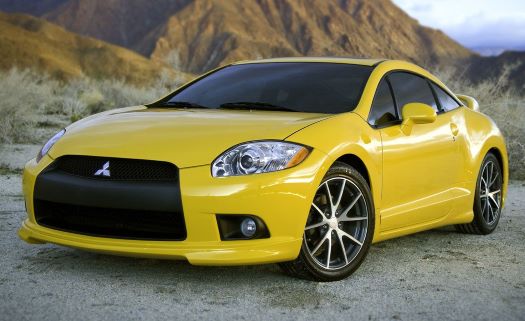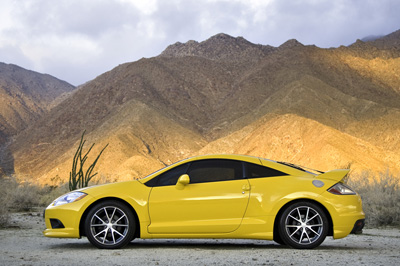
In today's high-priced used car market, many buyers are looking for "older" vehicles that have aged well as a way of getting a better budget fit. So, what about the Mitsubishi Eclipse?
The Eclipse had been around for over 20 years (from 1989 to 2012) ... a testament to its success as one of America's most popular sport cars at the time. The reason for its long run and wide acceptance can basically be boiled down to a combination of strong design styling, powerful engines, nimble performance, and reasonable comfort ... all while maintaining quite affordable prices.
Unfortunately, while fun to drive and fairly inexpensive, they are getting harder and harder to find with reasonable mileage and in good condition today. And generally, they just haven't aged particularly well, although some "good ones" can still be found out there with a careful and geographically expanded search.
And going back still further to the third generation (2000 - 2005) raises the mileage, condition, and reliability risks perhaps a bit too much, although there are always some extremely well-maintained and little-used exceptions. But here, we will be sticking to its last generation, the fourth, as a more viable option.
But clearly, in considering these fourth generation Eclipses, prospective buyers must weigh the benefits of better affordability against the potential drawbacks, such as higher maintenance/repair needs and outdated technologies.
So here, ...
- First, we'll look at what history has proven about the reliability of the fourth generation Eclipse (again, 2006 - 2012).
- We'll then list the possible mechanical issues as reported by owners so they can be checked before buying one today.
- Then we'll do an overview of its features and characteristics so potential buyers can get to know the vehicle better.
- We'll then point out what buyers the Eclipse may be, or not be, best suited for. In other words, its pros and cons.
But first, two very important suggestions ...
1. Things To Do When Considering An "Older" Eclipse:
Locate Lower Mileage Vehicles: They are certainly out there to be found with careful and patient shopping. Be willing to drive a distance if you have to.
Vehicle History and Maintenance: Ask for the vehicle history report (CarFax or AutoCheck) as well as documented maintenance and repair records. If not provided by the dealer or private seller, it's best to move on.
Pre-Purchase Inspection: Have the vehicle independently inspected before making a final decision. This usually will cost in the $150-$200 range but is well worth it given the potentially thousands in savings over the long term.
2. Know How To Get The Lowest Used Car Price:
Get Dealers To Compete For your Business: When you are searching vehicles to possibly purchase, the following is the absolute best way to get the lowest price, and it is extremely easy and stress-free.
Just go to a national car listing site, (I happen to prefer CarsDirect.com for their massive dealer participation and ease of use, although others will get the job done as well) and find several listed vehicles that you may be interested in.
Then write something like the following in the "Check Availability" box or "Contact Dealer" box or whatever the site you are using uses.
"Hello, I've contacted several dealers about cars I am interested in and am looking for the best value. I am also a serious buyer planning to make a decision soon. Please send me your best out-the-door price. Thank you.
After receiving the offers, follow up by explaining that based on the price, you're leaning in another direction but still really like their car and would certainly consider another offer. When dealers drop out, you'll know you're at the best price.
Using the internet to get dealers to compete for your business is extremely important. More details on this and how to intereact with the dealers can be found here at Best Used Car Buying Techniques.
4th-Gen Mitsubishi Eclipse Reliability
The fourth generation Eclipse has earned a mixed reputation for reliability and longevity. Here's a breakdown of key aspects:
Reliability:
Engines: This Eclipse came with two main engines: a 2.4L inline-4 (162 hp) and a 3.8L V6 (263 hp). The V6 offers better performance but is more prone to issues like oil leaks and valve cover gasket failures. The 4-cylinder is generally more reliable, though less powerful.
Transmission: Both automatic and manual transmissions are available. The automatic versions can develop issues over time, including slipping gears or hard shifts, especially if not well-maintained. The manual transmissions are typically more robust.
Longevity: Despite some common repairs (see below), a well-maintained fourth-gen Eclipse can last up to 200,000 miles or more. Regular oil changes, transmission servicing, and keeping an eye on common issues like oil leaks are key to ensuring its longevity.
Durability: The build quality has proven to be solid for the most part, but rust can be an issue in regions with harsh winters. Some interior plastics can also degrade with age.
Are They Still on the Road (the ultimate test of reliability)?: There are still fourth-gen Eclipses on the road, especially in regions with mild climates where rust isn't an issue. However, their numbers are decreasing as they age and some owners experience higher repair costs.
Overall: If you find a well-maintained Eclipse, it can still serve as a fairly reliable sporty-looking car. The 4-cylinder models tend to be more durable, but the V6 offers better performance at the cost of potential reliability issues. Regular maintenance is critical for ensuring these cars last as long as possible.
Fourth Generation (2006 - 2012) Mitsubishi Eclipse Possible Mechanical Problems

While well-maintained, good condition 4th-gen Eclipses are out there, it's also been established there are a number of possible mechanical problems that have been more common, and should therefore be included in an inspection before buying:
Oil Leaks: Especially in the V6 (3.8L) models, oil leaks around the valve cover gaskets are a fairly common issue. Over time, the seals degrade, leading to leaks that can cause engine damage if not addressed.
Transmission Issues: As stated earlier, automatic transmissions are known to possibly develop problems like slipping gears, hard shifts, and hesitation, especially if not maintained with regular fluid changes. The manual transmission is more durable, but some clutch components may wear out prematurely.
Suspension Wear: Suspension components, including control arm bushings, ball joints, and struts, tend to wear out after 80,000–100,000 miles. This can lead to clunking noises, poor ride quality, and uneven tire wear.
Braking System: While not widespread, some owners reported premature brake rotor warping, leading to vibration during braking, especially after high mileage or aggressive driving.
Electrical Issues: Electrical problems, such as faulty sensors (e.g., crankshaft or camshaft position sensors), malfunctioning power windows, and intermittent issues with the car’s ECU, are occasionally reported.

Cooling System Failures: Radiator and water pump failures can occur as the vehicle ages, leading to overheating and potential engine damage. Radiator cracks and water pump leaks have been reported in some models.
Timing Belt/Chain Issues: The 4-cylinder engines use a timing belt, while the V6 uses a timing chain. The timing belt requires periodic replacement (usually around 60,000–100,000 miles) to avoid catastrophic engine failure. Timing chains in the V6, while more durable, can still wear out or stretch over time.
Exhaust System Corrosion: In regions with harsh winters, the exhaust system can be prone to rust and corrosion, leading to leaks and noise.
Fuel System Problems: Some owners report issues with the fuel pump failing, which can cause stalling or difficulty starting the vehicle.
2006 - 2012 Mitsubishi Eclipse Overview

Like most vehicles with a long run, the Eclipse had undergone a number of changes to maintain its appeal. This fourth generation includes four trims: GS, SE, SE-V6 and GT. There were few changes during this run until 2009 when the SE models were dropped.
Under the hood of both the GS and SE is a 2.4-liter 4-cylinder engine rated at 162 horsepower and coupled with either a 5-speed manual transmission or a 4-speed automatic with a sequential Sportronic shift mode (still a lot of fun for those who prefer an automatic).
The Eclipse GT and SE-V6 models come with a powerful 3.8-liter V6, good for 263 horsepower. Eclipse GT models can be found with either a 6-speed manual transmission or a 5-speed automatic. Some have a 5-speed Sportronic as an option. They're also equipped with a sport-tuned suspension and 18-inch alloy wheels.
Standard equipment typically include full power accessories, 17-inch alloy wheels, foglights, air conditioning, keyless entry, a 6-speaker MP3 capable CD stereo, and split-folding rear seats.
The 2009 model year also saw the addition of stability control to the GT and a mild front end redesign for a somewhat more aggressive look. Some models from these years can also be found with popular options such as a sunroof and a Rockford Fosgate audio system.
For 2011, the Eclipse came with a "blackout" roof and also lowered the suspension about half an inch for a lower center of gravity. Also new was the addition of a rear backup camera and Bluetooth hands free calling to the Sun and Sound package. There was also a GS Sport trim that got the GT model's 18-inch wheels and blackout front end.
In it's final year, the 2012 Eclipse got two fairly minor changes: brake override logic and a clear lip spoiler on the GT trim.
Who Is The Eclipse Best Suited For?

Buying an Eclipse today can be a mixed decision, depending on what you are looking for in a car. Here are the pros and cons to consider:
Pros:
Affordability: They are generally affordable on the used car market, making them a more budget-friendly option for someone looking for a sporty coupe.
Stylish Design: The Eclipse has an aggressive, sporty look that still appeals to many today. It stands out compared to other cars in its class from the same era.
Performance (V6 Models): The V6 models offer decent power and a fun driving experience, particularly if you're after a more performance-oriented vehicle.
Reliable 4-Cylinder Engine: The 2.4L 4-cylinder models are generally more reliable than the V6 versions and can last a long time with regular maintenance.
Comfortable Interior: Despite its sporty design, the Eclipse provides a fairly comfortable ride, especially for a two-door coupe.
Cons:
Mechanical Issues: The Eclipse is known for several common mechanical problems, including oil leaks, transmission issues (especially with the automatic), and suspension wear. If you're not prepared for the possibility of costs for repairs and maintenance, these problems could make ownership frustrating.
Aging Technology: The car’s infotainment and tech features are outdated by modern standards, with limited connectivity options like Bluetooth or navigation.
Limited Practicality: The Eclipse is a two-door coupe, meaning rear seat space is cramped, and the trunk is smaller than most sedans or hatchbacks. It's not the most practical choice for families or long trips.
Decreasing Availability of Parts: As the Eclipse gets older and less common on the road, finding replacement parts for certain components (especially specific V6 parts) might become more challenging, although many components are still available today.
Fuel Economy: The V6 models are not fuel-efficient, averaging around 16-19 mpg city and 25-28 mpg highway, which is below average for today’s standards.
Who Should Consider Buying One:
Car Enthusiasts: If you're a fan of the Eclipse and appreciate its styling, performance, and history, it can be a fun project or weekend car, especially if you enjoy working on cars yourself.
Budget Buyers: If you find a well-maintained 4-cylinder model at a good price, it can be a reliable and stylish daily driver as long as you're prepared for the possibility of some repairs.
Who Should Avoid It:
Daily Commuters Needing Reliability: If reliability and minimal repair costs are your top priorities, this may not be the best choice. A newer car with fewer known issues would be more dependable.
Those Needing Practicality: Families or individuals needing more space or versatility should look at sedans or hatchbacks instead.
Overall:
Buy with Caution: If you find a fourth-gen Eclipse in good condition with service records showing regular maintenance, it could be a good deal. However, be prepared for some common repairs as the car ages. It’s important to have a trusted mechanic inspect the car thoroughly before buying, and look for signs of oil leaks, transmission health, and suspension wear.
If you want something more reliable, you might want to consider other vehicles from the same era such as the Mazda Miata or Scion tC.
 By Josh Rosenberg
By Josh Rosenberg